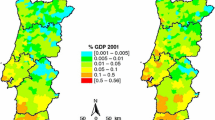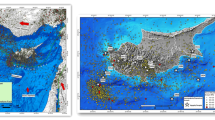Abstract
Seismic risk in the form of impending disaster has been seen from past records that moderate-to-large earthquakes have caused the loss of life and property in all parts of Nepal. Despite the availability of new data, and methodological improvements, the available seismic hazard map of Nepal is about two decades old. So an updated seismic hazard model at the country level is imperative and logical. The seismic hazard and risk model constitute important tools for framing public policies toward land-use planning, building regulations, insurance, and emergency preparedness. In fact, the reliable estimation of seismic hazard and risk eventually minimizes social and economic disruption caused by earthquakes. In this frame of reference, the seismic risk assessment at a country level is elementary in reducing potential losses stemming from future earthquakes. Thus, this study investigates structural vulnerability, seismic risk, and the resulting possible economic losses owing to future earthquakes in Nepal. To this end, seismic risk assessment in Nepal is done using an existing probabilistic seismic hazard, a newly developed structural vulnerability, and recently released exposure data. The OpenQuake-engine, the open-source platform for seismic hazard and risk assessment from the Global Earthquake Model initiative, was used to calculate the seismic hazard and risk in Nepal. The seismic hazard and mean economic loss map were formulated for the 1, 2, 5, and 10 % probability of exceedance in 50 years. Finally, the distribution of building damage and corresponding economic losses due to the recurrence of the historical 1934 earthquake was presented in this study.









Similar content being viewed by others
References
Abrahamson NA, Silva W (1997) Empirical response spectral attenuation relations for shallow crustal earthquakes. Seismol Res Lett 68:94–127
Abrahamson NA, Silva W (2008) Summary of the Abrahamson & Silva NGA ground-motion relations. Earthq Spectra 24(1):67–97
Abrahamson N, Gregor N, Addo K (2012) BC Hydro ground motion prediction equations for subduction earthquakes. Earthq Spectra
Atkinson GM, Boore DM (2003) Empirical ground-motion relations for subduction zone earthquakes and their application to Cascadia and other regions. Bull Seismol Soc Am 93(4):1703–1729
Atkinson GM, Boore DM (2006) Earthquake ground-motion prediction equations for eastern North America. Bull Seismol Soc Am 96(6):2181–2205
Atkinson GM, Boore DM (2011) Modifications to existing ground-motion prediction equations in light of new data. Bull Seismol Soc Am 101(3):1121–1135
BECA Worly International (New Zealand) in association with SILT Consultants (P.) Ltd. (Nepal), TAEC Consult (P.) Ltd. (Nepal), Golder Associates (Canada), Urban Regional Research (USA) (1994) Seismic hazard mapping and risk assessment for Nepal. GoN/UNDP/UNCHS (Habitat), Subproject 88/054/21.03, Kathmandu, Nepal
Bhattarai GK (2010) Probabilistic seismic hazard assessment and ground response analysis of Biratnagar sub-metropolitan city, Eastern Nepal. ME Thesis, Purbanchal University, Nepal
Bommer JJ, Spence R, Erdik M, Tabuchi S, Aydinoglu N, Booth E, Re DD, Pterken D (2002) Development of an earthquake model for Turkish catastrophe insurance. J Seismol 6:43–116
Boore DM, Atkinson GM (2008) Ground-motion prediction equations for the average horizontal component of PGA, PGV, and 5%-damped PSA at spectral periods between 0.01 and 10.0s. Earthq Spectra 24(1):99–138
BSSC (Building Seismic Safety Council) (2001) NEHRP Recommended Provisions for Seismic Regulations for New Buildings, and Other Structures, 2000 ed. Part 1: Provisions. Building Seismic Safety Council for the Federal Emergency Management Agency (Report FEMA368), Washington, DC, USA
Building Code Development Project (BCDP) (1994) Seismic hazard mapping and risk assessment for Nepal. GoN, Ministry of Housing and Physical Planning, Kathmandu
Campbell KW (2003) Prediction of strong ground motion using the hybrid empirical method and its use in development of ground motion (attenuation) relations in eastern North America. Bull Seismol Soc Am 93:1012–1033
Campbell KW, Bozorgnia Y (2008) NGA ground motion model for the geometric mean horizontal component of PGA, PGV, PGD and 5 % damped linear elastic response spectra for periods ranging from 0.01 to 10 s. Earthq Spectra 24(1):139–171
CEN Eurocode 8 (2004) Design of structures for earth quake resistance—Part 1: general rule, seismic actions and rule for buildings. EN 1998-1: 2004. Comit´e Europ´een de Normalisation, Brussels
Centre Bureau of Statistics (CBS) (2012) National Report, National Planning Commission Secretariat. Central Bureau of Statistics, Kathmandu, Nepal
Chaulagain H, Rodrigues H, Jara J, Spacone E, Varum H (2013) Seismic response of current RC buildings in Nepal: a comparative analysis of different design/construction. Eng Struct 49:284–294
Chaulagain H, Rodrigues H, Silva V, Spacone E, Varum H (2015) Earthquake loss estimation for the Kathmandu Valley. Bull Earthq Eng (in review)
China Earthquake Administration (CEA) (2005) Training material on seismic hazard analysis for Engineering Sites (GB17741-2005)
Chiou BSJ, Youngs RR (2008) An NGA model for the average horizontal component of peak ground motion and response spectra. Earthq Spectra 24(1):173–215
Crowley H, Bommer JJ, Pinho R, Bird J (2005) The impact of epistemic uncertainty on an earthquake loss model. Earthq Eng Struct Dyn 34:1653–1685
Crowley H, Borzi B, Pinho R, Colombi M, Ondida M (2008) Comparison of two mechanics-based methods for simplified structural analysis in vulnerability assessment. Adv Civ Eng 2008:19
Daniell JE, Wenzel F, Khazai B (2010) The cost of historic earthquakes today economic analysis since 1900 through the use of CATDAT. In: Proceedings of the Australian earthquake engineering society conference, Perth, Australia
Dixit A (2004) Promoting safer building construction in Nepal. Thirteen World Conference on Earthquake Engineering. Paper No: 1717
Douglas J, Bertil D, Roulle A, Dominique P, Jousset P (2006) A preliminary investigation of strong-motion data from the French Antilles. J Seismol 10(3):271–299
Douglas J, Cotton F, Alessandro C, Boore DM, Abrahamson NA, Akkar S (2012) Compilation and critical review of GMPEs for the GEM-PEER Global GMPEs Project. In: 15th world conference of earthquake engineering, Lisbon, Portugal
Erdik M, Aydinoglu N, Fahjan Y, Sesetyan K, Demircioglu M, Siyahi B, Durukal E, Ozbey C, Biro Y, Akman H, Yuzugullu O (2003) Earthquake risk assessment for Istanbul Metropolitan Area. Earthq Eng Eng Vib 2(1):1–23
Guragain R (2011) Development of fragility function for Nepalese building structure. Nepal National Building Code, 1994; modified by Guragain R, NSET, Nepal (unpublished)
Guragain R, Dixit A (2012) Development of fragility functions for low strength masonry buildings in Nepal using applied element methods. In: 15th world conference of earthquake engineering, Lisbon, Portugal
Housner GW (1989) Competing against time. Report to Governor Deukmejian of California, Governor’s Board of Inquiry on the 1989 Loma Prieta Earthquake
Jaiswal K, Wald D (2010) An Empirical model for global earthquake fatality estimation. Earthq Spectra 26(4):1017–1037
JICA (2002) The study on Earthquake disaster mitigation in the Kathmandu Valley, Kingdom of Nepal. Japan International Cooperation Agency and the Ministry of Home Affairs of Nepal, vol I, II and III
Kawashima K, Aizawa K, Takahashi K (1984). Attenuation of peak ground motion and absolute acceleration response spectra. In: Proceedings of eighth world conference on earthquake engineering, vol II, pp 257–264
Kramer S (1996) Geotechnical earthquake engineering. Prince Hall, New Jersey
Lava J, Avouac JP (2000) Active folding of fluvial terraces across the Siwaliks Hills, Himalayas of central Nepal. J Geophys Res 105:5735–5770
Lin P-S, Lee C-T (2008) Ground-motion attenuation relationships for subduction-zone earthquakes in northeastern Taiwan. Bull Seismol Soc Am 98(1):220–240
Mahajan AK, Thakur VC, Sharma ML, Chauhan M (2010) Probabilistic seismic hazard map of NW Himalaya and its adjoining area, India. Nat Hazards 53:443–457
Maskey PN (2005) Selection of attenuation laws for estimation of seismic input in Nepal. J Inst Eng 5:75–85
Meguro K (2008) Technological and social approaches to achieve earthquake safer non-engineered houses. In: Proceedings of 14th world conference on earthquake engineering, Beijing, China
Nath SK, Thingbaijam S (2012) Probabilistic seismic hazard assessment of India. Seismol Res Lett 83(1):135–149
NSET (2001) The Kathmandu Valley Earthquake risk management action plan, a Product of the Kathmandu Valley Earthquake Risk Management Project
Pandey MR, Tandukar RP, Avouac JP, Lave J, Massot JP (1995) Interseismic strain accumulation on the Himalayan crustal ramp (Nepal). Geophys Res Lett 22(7):751–754
Pandey MR, Chitrakar GR, Kafle B, Sapkota SN, Rajaure SN, Gautam UP (2002) Seismic hazard map of Nepal. Department of Mines and Geology, Kathmandu
Pandy MR, Tandukar RP, Avouac JP, Vergne J, Heritier T (1999) Seismotectonics of Nepal Himalaya from local seismic network. J Asian Earth Sci 17:703–712
Parajuli HR (2009) Dynamic analyses of low strength masonry houses based on site specific earthquake ground motions. PhD Thesis, Department of Urban Management, Graduate School of Engineering, Kyoto University, Japan
Raghu Kanth STG, Iyengar RN (2006) Seismic hazard estimation for Mumbai city. Curr Sci 91(11):1486–1494
Raghu Kanth STG, Iyengar RN (2007) Estimation of seismic spectral acceleration in peninsular India. J Earth Syst Sci 116(3):199–214
Rana BJB (1935) Nepal ko Maha Bhukampa (Great earthquake of Nepal). Jorganesh Press, Kathmandu
Shrestha B, Dixit AM (2008) Standard design for earthquake resistant buildings and aid to building code implementation in Nepal. Fourteen World Conference on Earthquake Engineering
Silva WJ, Gregor N, Darragh R (2002) Development of regional hard rock attenuation relations for central and eastern North America. Technical report, Pacific Engineering and Analysis, El Cerrito
Silva V, Crowley H, Pinho R, Varum H (2014a) Seismic risk assessment for mainland Portugal. Bull Earthq Eng 13(2):429–457
Silva V, Crowley H, Pinho R, Varum H (2014b) Investigation of the characteristics of Portuguese regular moment-frame RC buildings and development of a vulnerability model. Bull Earthq Eng. doi:10.1007/s10518-014-9669-y
Silva V, Crowley H, Pagani M, Monelli D, Pinho R (2014c) Development of the OpenQuake engine, the Global Earthquake Model’s open-source software for seismic risk assessment. Nat Hazards 72(3):1409–1427
Steward J, Douglas J, Boore D, Campbell K, Delavaud E, Erdik M, Stafford P (2015) Selection of a global set of ground motion prediction equations: work undertaken as part of Task 3 of the GEM-PEER Global GMPEs project. PEER Report 2012, Pacific Earthquake Research Centre
Thapa N (1988) BhadauPanchKoBhukampa (in Nepali). Central Disaster Relief Committee, Nepal
Thapa DR, Guoxin W (2013) Probabilistic seismic hazard analysis in Nepal. Earthq Eng Eng Vib 12:577–586
Upreti BN (1999) An overview of the stratigraphy and tectonics of the Nepal Himalaya. J Asian Earth Sci 17:577–606
Vamvatsikos D, Cornell CA (2006) Direct estimation of the seismic demand and capacity of oscillators with multi-linear static pushovers through IDA. Earthq Eng Struct Dyn 35:1097–1117. doi:10.1002/eqe.57
Wald D, Allen T (2007) Topographic slope as a proxy for seismic site conditions and amplification. Bull Seismol Soc Am 97:1379–1395
Wyss M (2005) Human losses expected in Himalayan Earthquakes. Nat Hazard 35:305–314
Wyss M, Nekrasova A, Kossobokov V (2012) Errors in expected human losses due to incorrect seismic hazard estimates. Nat Hazard. doi:10.1007/s11069-012-0125-5
Youngs RR, Chiou BSJ, Silva WJ, Humphrey JR (1997) Strong ground motion attenuation relationships for subduction zone earthquakes. Seismol Res Lett 68(1):58–73
Zhao JX, Zhang J, Asano A, Ohno Y, Oouchi T, Takahashi T, Ogawa H, Irikura K, Thio HK, Somerville PG, Fukushima Y, Fukushima Y (2006) Attenuation relations of strong ground motion in Japan using site classification based on predominant period. Bull Seismol Soc Am 96(3):898–913
Acknowledgments
This research investigation is supported by the Eurasian University Network for International Cooperation in Earthquake (EU-NICE), through a fellowship for Ph.D. research of the first author. This support is gratefully acknowledged.
Author information
Authors and Affiliations
Corresponding author
Rights and permissions
About this article
Cite this article
Chaulagain, H., Rodrigues, H., Silva, V. et al. Seismic risk assessment and hazard mapping in Nepal. Nat Hazards 78, 583–602 (2015). https://doi.org/10.1007/s11069-015-1734-6
Received:
Accepted:
Published:
Issue Date:
DOI: https://doi.org/10.1007/s11069-015-1734-6




